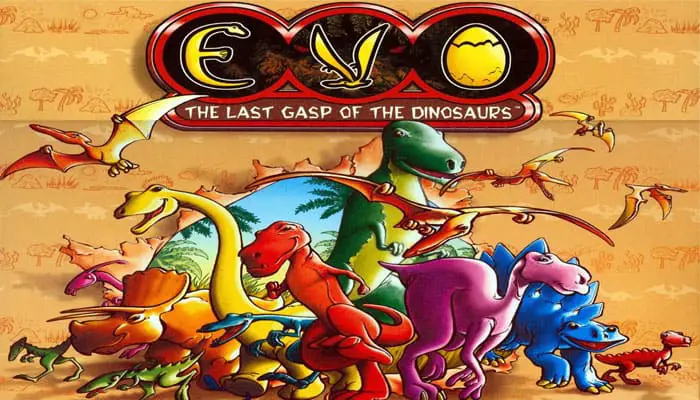
Components

- 2 double-sided boards
- 1 climate wheel
- 1 biology lab
- 5 clan markers (1 per player)
- 5 dinosaur boards (1 per player)
- 48 gene tokens
- 1 bag
- 88 MP tokens
- 40 dinosaurs (8 per player)
- 15 event cards
- 13 climate tokens
- 1 combat die
- Rulebook
Object of the Game
In EVO, you play a nomadic people in symbiosis with a primitive reptilian species. You travel the wild open spaces of Kumtagh with your mounts, you will use your knowledge of biology to help them adapt and succeed against both the hostile and changing climate and other competing species.
Technically, you will earn mutation points (MP in the remainder of the rules) during the course of the game.
The player with the most at the end of the game is the winner. In the event of a tie, the player with the most dinosaurs wins. If the game is still tied, it's a draw.
Setup
Set out the board corresponding to the number of players (the number of players is shown clearly on each board). Attention, they are double-sided!

Each player takes all the playing pieces in their color: 1 clan marker, 8 dinosaurs and 1 dinosaur board. In addition, each player receives 6 MP.
Place the biology lab and the climate wheel near the game board. The climate wheel should be set up as shown opposite. Shuffle the 15 event cards and make a face down deck with them.
Put all the normal gene tokens into the bag (36 in total). Add 8 unique gene tokens at random from the stock of 12.
 Normal Gene Tokens |
Then make the climate token pile. Remove the meteorite token: this will determine the end of the game. Discard one climate token at random without looking at it.

Make a face down pile of 3 climate tokens by shuffling the meteorite token and 2 other random tokens. Shuffle the remaining climate tokens and put them face down on top of this pile of 3.
When you've done this, the pile of climate tokens will contain 12 face down tokens, with the meteorite token somewhere in the bottom three.

ffff
Randomly determine a starting turn order by mixing up the players' clan markers and placing them on the appropriate spaces on the biology lab.
The player at the left of the initiative track is the starting player.
Finally, each player places a dinosaur token on each of the two starting areas nearest to them (or at random). The other dinosaur tokens are kept near the players.

Each player has a dinosaur board corresponding to the species with which his tribe is in symbiosis. These boards thus continuously show the characteristics of the various dinosaurs.
The following information is shown on each board, from left to right:
-

The area at the top of the board is used for the alchemical vials, whose effects are described later.
-

Legs
All the dinosaur species start with 2 movement points. Each extra pair of legs adds an extra movement point.
-
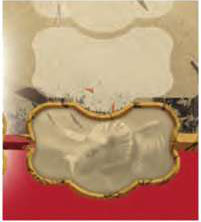
Horns
All the dinosaur species start without a horn. Horns are used for fighting by the dinosaurs. They can be added during the game.
-

Thermoregulation Layers
All the dinosaur species can acquire thermoregulation layers which enable them to survive in the hot areas on the island. They do not start with any layers but can acquire them during the game.
-

Fur Layers
all the dinosaur species can acquire fur layers which will enable them to survive in the cold areas on the island. They do not start with any layers but can acquire them during the game.
-

Eggs
All the dinosaur species start with one egg, which repre- sents their birth rate. This can be increased during the game.
-

The area at the bottom right is used to store unique genes, whose effects are described later.
-
Game Play
A game of EVO takes a certain number of rounds (between 9 and 11).
During each round, the following 6 phases must be resolved in this specific order. A given phase must be totally resolved before moving on to the next one.
-
Climate Phase
The starting player turns over the climate token on the top of the pile and applies its effect. If the meteorite token appears, the game stops immediately and the winner is determined.
-
Mutations Phase
The starting player randomly draws the genes that will be made available this round. The players will bid MP in order to acquire them.
-
Initiative Phase
The new player order is determined. This will remain unchanged until the next initiative phase.
-
Movement Phase
Players move their dinosaurs in initiative order. This can cause fights to occur: these are resolved immediately.
-
Birth Phase
Players "lay" new dinosaurs in initiative order.
-
Survival Phase
The starting player verifies that all the dinosaurs can survive in the spaces where they are currently located. The climate can cause a number of animals to die. Each player then earns MP depending on the number of dinosaurs present on the island at the end of the Survival phase.
Climate Phase
The starting player turns over the top climate token and applies its effect.
If the meteorite token appears, the game ends immediately and the winner is determined. The players reveal their MP tokens and the one with the most is the winner.
Otherwise, the starting player modifies the climate by turning the climate wheel in the direction shown on the revealed token:
-

Move the climate wheel two sections clockwise.
-

Move the climate wheel one section clockwise.
-

The climate wheel remains unchanged.
-

Move the climate wheel one section anticlockwise.
The selected section determines the climate for the current round. It is vitally important that all the players understand what that implies for the survival of their dinosaurs.
Mutation Phase
The starting player draws gene tokens out of the bag, one by one, and adds them to the biology lab until there are as many lines filled as there are players. Since the first line does not contain a space for a gene, the number of genes drawn will always be one fewer than the number of players.
There can never be two identical genes in the same mutation phase. If this happens, the starting player returns the extra gene to the bag and draws a new one to replace it.
Then, in initiative track order, the players bid for the available genes. Genes are paid for using MP. Since these are also victory points, be careful about how you spend them!
When it's their turn to bid, players place their clan marker opposite the token they would like to have (or on the first column, see below).
If the column is empty, the marker can be placed wherever the player likes (but the value chosen represents the number of MP that the gene will cost).
If the column is already occupied, the marker must be placed on a higher value than the marker that's already there, thus increasing the bid.
A player who has been outbid by another immediately removes his marker and makes a new bid. The new bid must be on a different column (however, if he is displaced again later, he can make a fresh bid on the original column).
Note that if a player bids 6 on a column, he cannot be outbid and therefore will always win the gene in question.
The player who won the bidding for the first column takes an event card.
The other players take the gene from the column that they won.
All the players must pay for their bids by handing in the appropriate number of MP to the bank.
Normal Genes
The effects of normal genes are permanent.
-

Pair of legs
Each extra pair of legs adds 1 additional movement point to your species. Each species starts the game with 2 movement points.
-
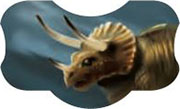
Horn
Each horn increases your chances of winning a fight, both in attack and defense. The dinosaurs start the game without any horns.
-

Thermoregulation Layers
Each layer enables a dinosaur to survive in a hot climate. Each species starts without any thermoregulation layers.
-

Fur Layers
Each layer enables a dinosaur to survive in a cold climate. Each species starts without any fur layers.
-

Egg
Each egg enables a new dinosaur to be laid each round. Each species starts with one egg.
-

Alchemical Vial
Each vial reduces the cost of genes and cards bought in subsequent rounds by 1 (minimum 0).
Unique Genes
The effects of the unique genes are permanent.
-

Bony Plates
This gene acts like 2 horns when defending (when one of your dinosaurs is attacked).
-

Large Horn
This gene acts like 2 horns when attacking (when one of your dinosaurs attacks another one).
-

Thick Shell
During the Birth phase, you can place your new dinosaurs up to 3 spaces away.
-

Flippers
One of your dinosaurs can move from one coastal space to another coastal space by paying 1 movement point. A space is coastal if it is next to the sea.

-

Wings
One of your dinosaurs can move 2 spaces by paying 1 movement point. The first space can contain a dinosaur (including another player's). This gene can only be used once per Movement phase.
-

Regeneration
You can never have fewer than 3 dinosaurs. If you have only 3, you cannot be attacked, you are no longer affected by the climate, etc.
-

Killer Babies
You can add new dinosaurs to occupied spaces. Roll a die for each dinosaur so added. The opposing dinosaur is eliminated on a roll of
 . On a roll of
. On a roll of  your dinosaur dies.
your dinosaur dies. -

Sixth Sense
You can look at the next climate token whenever you like.
-
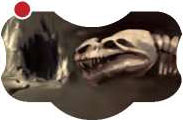
Cave Dweller
One of your dinosaurs in a deadly area during the Survival phase survives.
-

Adrenaline Rush
You can freely choose your spot on the initiative track during the initiative phase.
-
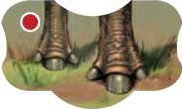
Strong Thighs
This gene provides you with 2 extra movement points.
-
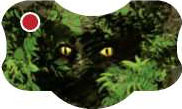
Chameleon Skin
When you lose a fight, your dinosaur can move onto an adjacent space (but not the one from which the attacker came) instead of being killed. If no legal space is available, it dies.
Event Cards
Each round, the player who won the bidding on the first column of the biology lab takes a random event card. These cards are kept secret until they are used. More than one may be played in a given round or phase as long as the correct timing for playing the card is respected.
The effects of an event card are never permanent and they are discarded after use.

Initiavive Phase
All the clan markers are placed on the initiative track at the top of the column they occupied at the end of the previous phase. Then they are sorted in increasing order by the number of dinosaurs on the board (retaining the order in the case of a tie). Thus, players will fewer dinosaurs will go first.
Movement Phase
Beginning with the starting player and continuing in initiative track order, each player moves their dinosaurs. Initially, each dinosaur species has 2 movement points.
An extra point is acquired for each additional pair of legs. The available movement points must be divided among all the dinosaurs of the species. Each movement point enables ONE dinosaur to move one space.

Example: a species that has 3 movement points could move 3 dinosaurs one space each, or one dinosaur 2 spaces and then another dinosaur a single space.
Dinosaurs are not allowed to move through or stop on a space that is already occupied by another dinosaur (friend or not). You are not required to use up all the available movement points.
The only way to enter a space containing an enemy dinosaur is to start a fight, as follows:
The moving player spends a movement point and indicates which space is being attacked. He rolls the combat die. Two outcomes are possible (see sidebar) :
The attacking dinosaur wins and takes the place of the defeated animal. The losing dinosaur is removed from the game.
The attacking dinosaur loses. The two dinosaurs stay where they are.
It is perfectly possible to attack the same dinosaur more than once, even with the same attacker. The only thing to bear in mind is that combat always costs 1 movement point.

Attack fails.

Attack succeeds.

If the attacking dinosaur has at least as many horns as the defender then the attack succeeds (if neither of the two dinosaurs has a horn, the attack succeeds).

If the attacking dinosaur has more horns than the defender then the attack succeeds.

If the attacking dinosaur has at least two horns more than the defender then the attack succeeds.
Important: A clan that only has two dinosaurs may not be attacked.
Birth Phase
The player places a new dinosaur pawn on a space adjacent to one of his dinosaurs. Once all the players have done this, players with two eggs repeat the process, then again for players with three eggs, and so on for players with more eggs.
A player who already has all 8 dinosaurs on the board is allowed to eliminate one of them in order to bring a new one on elsewhere.
Survival Phase
Beginning with the starting player and continuing in initiative track order, each player eliminates the dinosaurs that haven't been able to resist the island's hostile climate, as follows:
Beginning with the starting player and continuing in initiative track order, each player can add new dinosaurs as follows:
-
On ideal terrain, all the dinosaurs survive.
-
On deadly terrain, all the dinosaurs die.
-
On hot terrain, the player can enable one of his dinosaurs to survive for each thermoregulation layer on his board. All the other dinosaurs die.
-
On cold terrain, the player can enable one of his dinosaurs to survive for each fur layer on his board. All the other dinosaurs die.
Each player removes the dead dinosaurs in the order of his choice and stops if he only has two remaining on the board.
Finally, each player receives one MP for each of his dinosaurs on the game board. Then the next round begins.
Continue Reading

